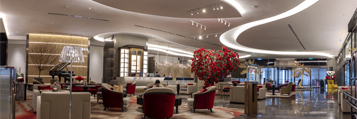


Get inspired and explore art and cultural essences from Peninsular Malaysia’s East Coast states, Pahang, Terengganu and Kelantan.
Location: Level 2, Malay Village
Our Art, Our Home
The SeniKome Péng Hēng is truly a hidden gem where exploration and inspiration come together. Located in Level 2, Malay Village, it features a thematic showcase of art and cultural essences from Peninsular Malaysia’s East Coast states, Pahang, Terengganu and Kelantan.
SeniKome, which directly translates to “Our Art” in the Pahang local dialect is dedicated to promoting the beauty of East Coast Malaysia’s local heritage, craft, fashion, games, food and music. From authentic artifacts and paintings to the indigenous people or ‘orang asli’ exhibition, SeniKome tastefully depicts the distinctive charm of Péng Hēng, a traditional reference to the East coast region which dates back to the Ming Dynasty.
With the vision to preserve and promote art and culture from the East Coast, SeniKome Péng Hēng is a one-stop attraction that brings a vibrant element of Malaysian heritage to life.
Tenun
The Tenun fabric is believed to have originated from Riau or Sulawesi since the 16th century. Its intricate patterns have become the identity of Pahang, symbolising status, ethnic identity, beliefs, and religious rituals. This fabric is suitable as a samping for baju melayu and wedding attire, often adorned with gold threads that create fine lines or scattered floral motifs.
Songket
Songket is a traditional handwoven fabric, historically crafted by women using gold or silver threads woven into a colourful background. The technique, dating back to the 16th century, creates ornate patterns of geometric shapes and organic elements like flowers. Once reserved for royalty, songket is now worn in ceremonies, weddings, and formal events. Men contribute by making the weaving equipment.
Kercang
Kercang is a type of traditional Malay game made from rattan loops arranged to form various shapes. In the past, this game was very popular among the Orang Asli (Jakun ethnic group) and the old Malay communities living in the remote forest areas of Endau.
Wayang Kulit
Wayang Kulit is a traditional shadow puppetry where carved leather figures are projected on a screen using light. The dalang (puppet master) manipulates the figures to bring the shadows to life. With roots in the Ramayana, it came to Malaysia before pre-Islamic times, evolving into Hikayat Maharajawana. The tale shifted to focus on the antagonist Maharajawana (Ravana) and modernised in the 1970s with new characters and music.
Gamelan
Gamelan is traditional ensemble music from the Javanese, Sundanese, and Balinese peoples of Indonesia, mainly featuring metallophones, hand drums (kendang), and other instruments like xylophones, bamboo flutes, and the rebab. It accompanies rituals, ceremonies, and performances. Recognised as part of Indonesia's National Intangible Cultural Heritage in 2014, Gamelan was added to UNESCO's Intangible Cultural Heritage list in 2021.
Keris
The keris originated in Java and spread throughout the Nusantara. It is a short Austronesian weapon that has been used for 600 years. The story of Hang Tuah and the Keris Tamingsari, as well as its prominence in royal emblems and weddings, make the keris unique to the Malay ethnic group. The keris was recognised as the ‘Karya Agung Warisan Lisan dan Tidak Ketara Kemanusiaan’ (Masterpiece of the Oral and Intangible Heritage of Humanity) by UNESCO in 2005.
Jebak Puyuh
Jebak Puyuh is a heritage craft that is increasingly forgotten. Once commonly used as traps for small birds like quail, its unique design combines weaving techniques with wood carving. For instance, the Jebak Puyuh from Terengganu is made from angsana wood. The carved ‘jenang’ (frame) features silat perforated designs, including motifs of breadfruit flowers and bean shoots, along with an ‘awan larat’ pattern. The left and right sides are adorned with the dala flower motifs.
Q: Where is SeniKome Péng Hēng located?
A: Level 2, Malay Village, First World Plaza
Q: What does SeniKome Péng Hēng mean?
A: SeniKome is a translation of “Our Art” in the Pahang local dialect. Péng Hēng was used to refer to the East Coast regions of the Malay Peninsula back in the Ming Dynasty in the 1520’s.
Q: What are the east coast states of Malaysia?
A: Kelantan, Terengganu and Pahang.
Q: Are we allowed to touch the displays?
A: Unfortunately, our hands contain harmful oils and bacteria that can damage the delicate displays. Let’s work together to preserve the displays to the best of our ability so that other customers can enjoy them too – just like you!
Q: Is the gallery child-friendly?
A: Yes, children will have a fun time learning about the culture.
Q: Is photography allowed?
A: Yes.